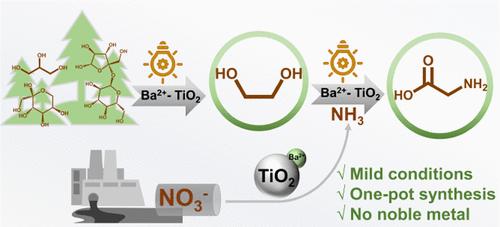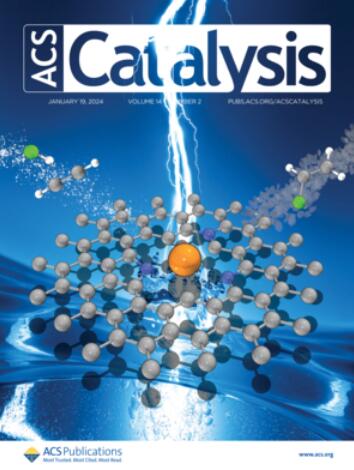生物质和硝酸盐光催化转化为甘氨酸的研究
IF 11.3
1区 化学
Q1 CHEMISTRY, PHYSICAL
引用次数: 0
摘要
生物质是一种来自植物的可再生碳源,含有来自太阳的化学能。硝酸盐是一种解离能较低的含氮原料,在废水中分布丰富。可再生生物质和硝酸盐废物可以通过光催化过程转化为有价值的C-N产品,这在不同种类的化学品和燃料的生产中变得越来越有前途,但也具有挑战性。本文报道了在Ba2+修饰的TiO2催化剂上,生物质和硝酸盐光转化为甘氨酸的产率为765 μmol gcat-1 h-1,产率为15.3%。该过程串联了多个反应,包括生物质光重整为乙二醇,硝酸盐还原为NH3,最后C-N偶联为甘氨酸,其中硝酸盐离子在生物质的选择性裂解和氧化中起主导作用。令人惊讶的是,经过水解预处理后,生物多元醇或糖,甚至生木锯末都可以与硝酸盐反应生成甘氨酸。本研究为可再生生物质和硝酸盐废弃物在温和条件下生产甘氨酸提供了一个有效的催化体系。本文章由计算机程序翻译,如有差异,请以英文原文为准。

Photocatalytic Conversion of Biomass and Nitrate into Glycine
Biomass is a renewable carbon source that comes from plants, containing chemical energy from the sun. Nitrate, which is a N-containing feedstock with a lower dissociation energy, has a rich distribution in wastewater. Renewable biomass and nitrate waste can be converted into valuable C–N products through photocatalytic processes, which is becoming promising but challenging in the production of different kinds of chemicals and fuels. Herein, we report the photoconversion of biomass and nitrate into glycine with a 765 μmol gcat–1 h–1 production rate and 15.3% yield over a Ba2+-modified TiO2 catalyst. The process cascades multiple reactions containing the photoreforming of biomass to glycol, nitrate reduction to NH3, and finally, C–N coupling to glycine, among which nitrate ions play a dominant role in the selective cleavage and oxidation of biomass. Surprisingly, after hydrolysis pretreatment, biopolyols or sugars and even raw wood sawdust could react with nitrate to generate glycine. This study provides an effective catalytic system to produce glycine from renewable biomass and nitrate waste under mild conditions.
求助全文
通过发布文献求助,成功后即可免费获取论文全文。
去求助
来源期刊

ACS Catalysis
CHEMISTRY, PHYSICAL-
CiteScore
20.80
自引率
6.20%
发文量
1253
审稿时长
1.5 months
期刊介绍:
ACS Catalysis is an esteemed journal that publishes original research in the fields of heterogeneous catalysis, molecular catalysis, and biocatalysis. It offers broad coverage across diverse areas such as life sciences, organometallics and synthesis, photochemistry and electrochemistry, drug discovery and synthesis, materials science, environmental protection, polymer discovery and synthesis, and energy and fuels.
The scope of the journal is to showcase innovative work in various aspects of catalysis. This includes new reactions and novel synthetic approaches utilizing known catalysts, the discovery or modification of new catalysts, elucidation of catalytic mechanisms through cutting-edge investigations, practical enhancements of existing processes, as well as conceptual advances in the field. Contributions to ACS Catalysis can encompass both experimental and theoretical research focused on catalytic molecules, macromolecules, and materials that exhibit catalytic turnover.
 求助内容:
求助内容: 应助结果提醒方式:
应助结果提醒方式:


